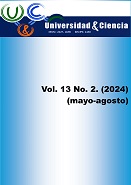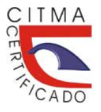Structural analysis of a 12 m lighting pole affected by hurricane winds
DOI:
https://doi.org/10.5281/zenodo.11200912Keywords:
computational fluid dynamics, metal structure, structural analysisAbstract
Objective: To perform the structural analysis of the 12 m pole designed and manufactured by Empresa Mecánica Bayamo (EMBA). Method: Computational Fluid Dynamics (CFD) was used to assess the effect of wind loads from a Category 3 hurricane according to the Saffir-Simpson scale. Considering this effect, as well as the permanent loads, static structural studies were conducted to determine the stresses and displacements of the structure. Results: The stresses evaluated were von Mises stresses, which yielded a maximum value of 156.4 MPa and a displacement in the wind deflection of 210.6 mm. Conclusion: Based on the maximum stresses, the minimum safety factor obtained was 1.2, demonstrating that the deformations caused under the study's conditions will not be permanent, while the displacements are considered acceptable given the magnitude of the loads and the pole's height.
Downloads
References
Apsley, D. D. (2024). CFD simulation of tidal-stream turbines in a compact array. Renewable Energy, 224, 120133. https://doi.org/https://doi.org/10.1016/j.renene.2024.120133
Avila Alonso, D., Baetens, J. M., Cardenas, R. y Baets, B. de (2019). The impact of hurricanes on the oceanographic conditions in the Exclusive Economic Zone of Cuba. Remote Sensing of Environment, 233, 111339. https://doi.org/https://doi.org/10.1016/j.rse.2019.111339
Barrera, E. F., Aguirre, F. A., Vargas, S. y Martínez, E. D. (2018). Influencia del Y Plus en el Valor del Esfuerzo Cortante de Pared a través Simulaciones empleando Dinámica Computacional de Fluidos. Información tecnológica, 29(4), 291-302. https://doi.org/http://dx.doi.org/10.4067/S0718-07642018000400291
British Standards Institution. (2019). BS EN 10025-2:2019 Hot rolled products of structural steels - Part 2: Technical delivery conditions for non-alloy structural steels. In (pp. 44). London: BSI.
Camelo, J. y Mayo, T. (2021). The lasting impacts of the Saffir-Simpson Hurricane Wind Scale on storm surge risk communication: The need for multidisciplinary research in addressing a multidisciplinary challenge. Weather and Climate Extremes, 33, 100335. https://doi.org/https://doi.org/10.1016/j.wace.2021.100335
Coll, P. y Pérez, A. (2021). Climatología de los ciclones tropicales que tocaron tierra en Cuba entre 1980 y 2019. Revista Cubana de Meteorología, 27(4), 1-11. https://cu-id.com/2377/v27n4e06
Geng, F., Suiker, A. S. J., Rezaeiha, A., Montazeri, H. y Blocken, B. (2023). A computational framework for the lifetime prediction of vertical-axis wind turbines: CFD simulations and high-cycle fatigue modeling. International Journal of Solids and Structures, 284, 112504. https://doi.org/https://doi.org/10.1016/j.ijsolstr.2023.112504
González, C. M. y Ramos, L. E. (2019). Cronología de las tormentas tropicales y huracanes que han afectado a La Habana. Revista Cubana de Meteorología, 25(3), 469-480. http://opn.to/a/TIUtR
Kantha, L. (2013). Classification of hurricanes: Lessons from Katrina, Ike, Irene, Isaac and Sandy. Ocean Engineering, 70, 124-128. https://doi.org/https://doi.org/10.1016/j.oceaneng.2013.06.007
Li, Y., Yang, S., Feng, F. y Tagawa, K. (2023). A review on numerical simulation based on CFD technology of aerodynamic characteristics of straight-bladed vertical axis wind turbines. Energy Reports, 9, 4360-4379. https://doi.org/https://doi.org/10.1016/j.egyr.2023.03.082
Martín, P., Fernández, I. y Parnás, V. E. (2019). Estudio comparativo de normas para el análisis dinámico de una torre autosoportada bajo carga de viento. Informes de la Construcción, 70(552), 1-11. https://doi.org/https://doi.org/10.3989/ic.15.021
Mengistu, M. T., Orlando, A. y Repetto, M. P. (2023). Wind and structural response monitoring of a lighting pole for the study of downburst effects on structures. Journal of Wind Engineering and Industrial Aerodynamics, 240, 105447. https://doi.org/https://doi.org/10.1016/j.jweia.2023.105447
Montero, O. P. y Batista, C. M. (2020). Social perception of coastal risk in the face of hurricanes in the southeastern region of Cuba. Ocean & Coastal Management, 184, 105010. https://doi.org/https://doi.org/10.1016/j.ocecoaman.2019.105010
Mott, R. L. (2006). Diseño de elementos de máquinas (4ta ed.). Pearson Educación.
Pineda, G. V., Cepeda, J. L. y López, E. F. (2023). Análisis de convergencia de malla en simulación computacional de prueba de choque en asiento de autobús. Universidad y Sociedad, 15(S2), 185-191. https://rus.ucf.edu.cu/index.php/rus/article/view/3879
Tong, H., Halilaj, E. y Zhang, Y. J. (2024). HybridOctree_Hex: Hybrid octree-based adaptive all-hexahedral mesh generation with Jacobian control. Journal of Computational Science, 78, 102278. https://doi.org/https://doi.org/10.1016/j.jocs.2024.102278
Wijesooriya, K., Mohotti, D., Lee, C.-K. y Mendis, P. (2023). A technical review of computational fluid dynamics (CFD) applications on wind design of tall buildings and structures: Past, present and future. Journal of Building Engineering, 74, 106828. https://doi.org/https://doi.org/10.1016/j.jobe.2023.106828
Downloads
Published
How to Cite
Issue
Section
License
Copyright (c) 2024 Universidad & ciencia

This work is licensed under a Creative Commons Attribution-NonCommercial-ShareAlike 4.0 International License.





















